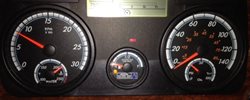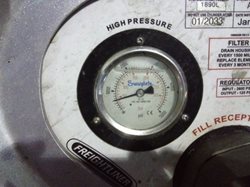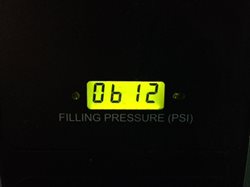I have now reached a new low point in my usage of CNG as a fuel source and it has given me a better understanding of the operational capacity of my natural gas powered Freightliner Cascadia. It all started with a phone call that I received from fellow Team Run Smart pro Henry Albert, in which we briefly talked about the low fuel light and the potential for running beyond it. Knowing where you’re truck can get you beyond the yellow low fuel light can be a very important piece of information and can help better familiarize you with

knowing your truck’s exact operating limits. Not without risk, certain precautions should be taken for doing so, such as a spare fuel jug with some emergency diesel fuel in it. This is something not easily done with a CNG truck though, as it is not as simple as a fuel can full of fuel to get you back on the road!
Feeling inspired to test the exact limits of my truck, I decided to push the envelope of my truck’s fuel capacity to better understand the limits of my CNG fueled truck. One of the major disadvantages of CNG, not to be outweighed by the operational savings, is of course the need to fuel more often. In my case it is typically every day and a half for local driving with a 140-gallon diesel gallon equivalent (DGE) set of tanks. This of course means precious time wasted that could be used instead hauling and earning revenue. I knew that this was not the very limits of the CNG system I was equipped with, but have been

instructed to be wary of running out of fuel, as a low pressure system can leave you stranded and in need of a costly tow to the nearest station. With this in mind, I usually headed for my nearest station just prior to reaching ¼ of a tank, or somewhere around 1000 psi on my typical 3800-4000 psi full capacity fills. In my mind I figured it was time to try and extend my fueling interval to increase my total savings by freeing up some of my refueling time during the week.
With an eagle eye on the my already 1/3 of a tank gauge, I decided to continue on with my trip into Los Angeles from Ontario, just to see if I could make it to refuel back in Fontana, which was on my return trip back to the rail yard in San Bernardino. As I drove and watched the gauge droop below the usual ¼-tank mark, it became apparent that the trip was going to be a nail biter, since I had not even arrived at my pickup location in Los Angeles yet! I would be lying if I said I wasn’t sweating it on the way back to the rail yard, especially since this load turned out to be about 10,000 pounds heavier than originally planned and traffic was not it’s usually smooth flow for that time of morning! When I safely reached Fontana and hooked up the hose to begin the refueling process, the pressure readout on the pump confirmed that I was at the lowest pressure I had ever been at prior to refueling, reading out on the display a pressure of 612

psi. Being that I had heard that these trucks would stop somewhere around 700 psi from lack of fuel pressure, I was pretty proud (and lucky) to have gone below the threshold and remained in full operating capacity. Being that I now know the limits of my truck a little better though, I can easily stretch the fueling intervals to a comfortable two or even two and a half day cycle. Although a gutsy move, this will now help me maximize the savings by potentially cutting out one unnecessary fuel stop nearly every week!